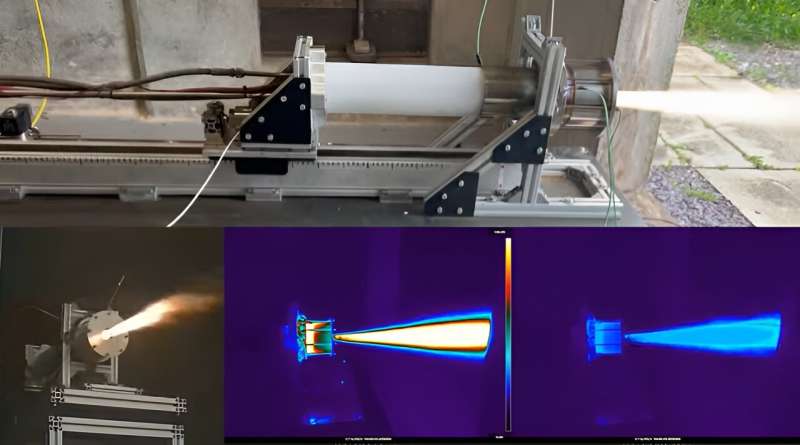This article has been reviewed according to Science X's editorial process and policies. Editors have highlighted the following attributes while ensuring the content's credibility:
fact-checked
trusted source
proofread
'Self-eating' rocket could help UK take a big bite of space industry

New developments on a nearly century-old concept for a "self-eating" rocket engine capable of flight beyond the Earth's atmosphere could help the U.K. take a bigger bite of the space industry.
University of Glasgow engineers have built and fired the first unsupported autophage rocket engine which consumes parts of its own body for fuel. The design of the autophage engine—the name comes from the Greek word for "self-eating"—has several potential advantages over conventional rocket designs.
The engine works by using waste heat from combustion to sequentially melt its own plastic fuselage as it fires. The molten plastic is fed into the engine's combustion chamber as additional fuel to burn alongside its regular liquid propellants.
This means that an autophage vehicle would require less propellant in onboard tanks, and the mass freed up could be allocated to payload instead. The consumption of the fuselage could also help avoid adding to the problem of space debris—discarded waste that orbits the Earth and could hamper future missions.
Overall, the greater efficiency could help autophage rockets take a greater payload into space compared to a conventional rocket of the same mass. They could, for example, take tiny "nanosatellites" into space directly without having to share space on more expensive conventionally-fueled rockets.
The concept of a self-eating rocket engine was first proposed and patented in 1938. However, no autophage engine designs were fired in a controlled manner until a research partnership between the University of Glasgow and Dnipro National University in Ukraine achieved this milestone in 2018.
Now the Glasgow engineers have demonstrated that more energetic liquid propellants can be used, and that the plastic fuselage can withstand the forces required to feed it into the engine without buckling. These are essential steps in developing a viable flight concept.
The team's paper, titled "Investigation of the Operating Parameters and Performance of an Autophage, Hybrid Rocket Propulsion System," was presented at the AIAA SciTech Forum on Wednesday 10 January in Orlando, Florida.
In the paper, the team describe how they successfully test-fired their Ouroborous-3 autophage engine, producing 100 newtons of thrust in a series of controlled experiments. The test fires were conducted at the MachLab facility at Machrihanish Airbase.
The Ouroborous-3 uses high-density polyethylene plastic tubing as its autophagic fuel source, burning it alongside the rocket's main propellants—a mix of gaseous oxygen and liquid propane.
The tests showed that the Ourobourous-3 is capable of stable burn—a key requirement for any rocket engine—throughout the autophage stage, with the plastic fuselage supplying up to one-fifth of the total propellant used.
The tests also showed that the rocket's burn could be successfully controlled, with the team demonstrating its ability to be throttled, restarted and pulsed in an on/off pattern. All of these abilities could help future autophage rockets control their ascent from the launchpad into orbit.
Professor Patrick Harkness, of the University of Glasgow's James Watt School of Engineering, led the development of the Ourouboros-3 autophage engine. He said, "These results are a foundational step on the way to developing a fully-functional autophage rocket engine. Those future rockets could have a wide range of applications which would help advance the U.K.'s ambitions to develop as a key player in the space industry.
"A conventional rocket's structure makes up between 5% and 12% of its total mass. Our tests show that the Ouroborous-3 can burn a very similar amount of its own structural mass as propellant. If we could make at least some of that mass available for payload instead, it would be a compelling prospect for future rocket designs."
Postgraduate researcher Krzysztof Bzdyk, of the James Watt School of Engineering, is the paper's corresponding author. He said, "Getting to this stage involved overcoming a lot of technical challenges but we're delighted by the performance of the Ourouboros-3 in the lab.
"From here, we'll begin to look at how we can scale up autophage propulsion systems to support the additional thrust required to make the design function as a rocket."
The autophage engine is one of 23 space technology projects recently selected to share in £4m from the U.K. Space Agency and STFC. The Glasgow team received £290,000 to help establish further pilot testing of the prototype engine.
Dr. Paul Bate, CEO of the UK Space Agency, said, "One of the key ways we catalyze investment into the U.K.'s growing space sector is by backing innovations in emerging areas of space technology. The University of Glasgow's impressive work towards an autophage engine is an example of one which has great potential to meet the growing global appetite for developments in the efficiency and sustainability of rocket propulsion."
Jack Tufft, a postgraduate researcher at the James Watt School of Engineering, is a co-author of the paper. He said, "We're really excited by the potential of the Ouroboros-3, and this further funding will help us move forward with exploring new developments and refinements to our design. Our aim is to bring the autophage engine closer to a test launch, which will help us develop our design for future generations of autophage rockets."
More information: Investigation of the Operating Parameters and Performance of an Autophage, Hybrid Rocket Propulsion System. arc.aiaa.org/doi/abs/10.2514/6.2024-1604
Provided by University of Glasgow





















